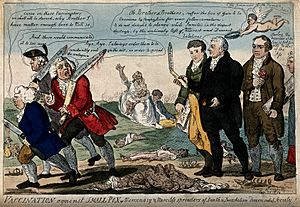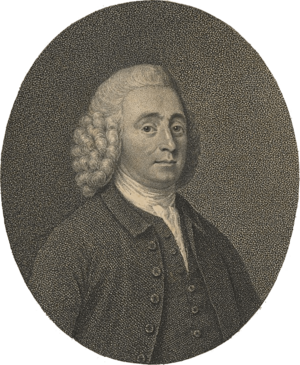Thomas Dimsdale facts for kids
Baron Thomas Dimsdale (born May 29, 1712 – died December 30, 1800) was an English doctor, banker, and politician. He was a member of the House of Commons, which is a part of the British Parliament, from 1780 to 1790. He was given the special title of Baron by Catherine the Great, who was the Empress of Russia.
Contents
Early Life and Medical Training
Thomas Dimsdale was born in Theydon Garnon, a town in Essex, England. His father, John Dimsdale, was also a surgeon, and his mother was Susan. His family belonged to the Quakers, a religious group.
Thomas learned medicine from his father first. Then, he continued his training at St Thomas’ Hospital in London. After finishing his studies, he started working as a doctor in Hertford in 1734.
How Did Thomas Dimsdale Help with Smallpox?
Thomas Dimsdale became very interested in preventing smallpox. Smallpox was a very serious and often deadly disease. He focused on a method called inoculation, also known as variolation.
What Was Inoculation?
Inoculation was a way to protect people from smallpox. It involved giving a person a very mild form of the disease. This was done by putting a small amount of the smallpox virus into a scratch on the skin. The idea was that the person would get a mild sickness. After recovering, they would be protected from the more dangerous types of smallpox.
In 1767, Dimsdale wrote a book called The present method of inoculating for the small-pox. This book became very popular. It had five different printings by 1769. Because of his important work, he was chosen to be a Fellow of the Royal Society in 1769. This is a group of very important scientists.
Dimsdale's Trip to Russia
In 1762, Thomas Dimsdale was invited to Russia. This was because of his growing fame as a doctor. The Empress of Russia, Catherine the Great, wanted him to inoculate her and her son, Grand Duke Paul.
In 1768, Dimsdale traveled to St. Petersburg, Russia. His second son, Nathaniel Dimsdale, went with him. There, he successfully inoculated the Empress, her son, and more than 140 people from the royal court.
Rewards from the Empress
The inoculations were a great success! Catherine the Great rewarded Dimsdale very generously. She gave him £10,000, which was a huge amount of money back then. She also gave him a yearly payment of £500 and £2,000 for his travel costs. Most importantly, she made him a Baron of the Russian Empire. His son Nathaniel also received a Barony.
The Empress had even planned for fast horses to be ready. This was in case the inoculations went wrong. The horses would have helped the Dimsdales escape quickly. During his time in Russia, Thomas Dimsdale also wrote another book called Tracts on inoculation written and published at St Petersburg in the year 1768.

Life After Russia
After returning from Russia, Dimsdale started a new career as a banker. He worked in a private banking company in London. Later, he became a partner in another bank called Staples, Baron Dimsdale, Son & Co.
He also became a politician. He was elected as a Member of Parliament (MP) for Hertford. He served in Parliament for two terms, from 1780 to 1790. In 1781, he and his son Nathaniel went back to Russia. They performed more royal inoculations there.
Family Life
Thomas Dimsdale was married three times. His first wife was Mary. His second wife was Anne, and they had seven sons and two daughters together. His third wife was Elizabeth, who was his cousin. His oldest son, John, inherited his Russian Barony. However, the Barony of John's son, Nathaniel, ended because he did not have any children to pass it on to.
Death and Legacy
Thomas Dimsdale lived in Bengeo, which is part of Hertford. A street there, Dimsdale Street, is still named after him. He died in 1800. He was buried in the Quakers' burial ground in Bishop's Stortford, Hertfordshire.


